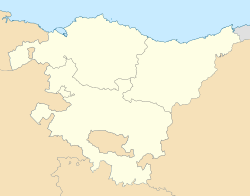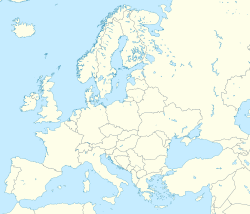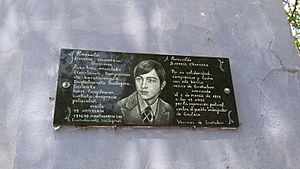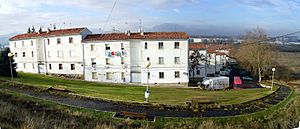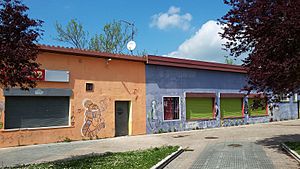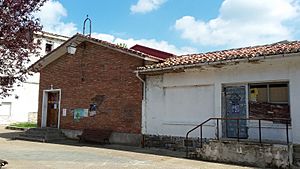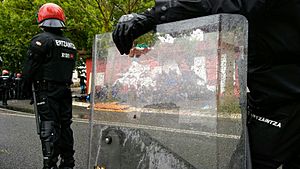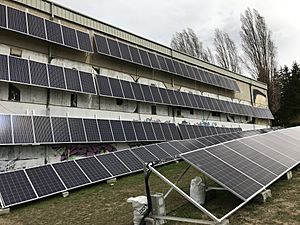Errekaleor facts for kids
Quick facts for kids
Errekaleor
|
|
|---|---|
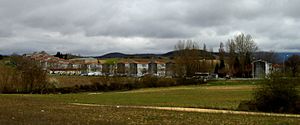 |
|
| Nickname(s):
Errekaleor Bizirik
|
|
| Area | |
| • Total | 10 ha (20 acre) |
| Population
(2017)
|
|
| • Total | 150 |
Errekaleor is a special neighborhood on the edge of Vitoria-Gasteiz, a city in the Basque Country, Spain. It sits on a flat area near the Errekaleor river, which is part of the city's green belt.
Since 2013, young people and families have moved into the empty buildings. They call their community Errekaleor Bizirik (which means Errekaleor Alive). This project is all about people managing things themselves. They make decisions together, support feminism, are against capitalism, and celebrate Basque culture.
Errekaleor Bizirik is the largest community of its kind in Spain. It covers over 10 hectares (about 25 acres) and has around 150 residents. These residents include kids, older people, workers, students, and teachers. The community has many cool projects. They have an organic farm, a bakery, a bar, a social center, a library, a theater, a free shop, and even a recording studio!
The neighborhood has 32 blocks of apartments, with six homes in each. There are also buildings like a school, church, and shops. These were part of the original neighborhood built in the 1950s. After the city government moved the first residents out, the area became empty. The city wanted to build new apartments. But due to money problems, these plans never happened. So, the area was unused for years until the community moved in.
Contents
How Errekaleor Started
In the 1950s, Errekaleor was built to house workers. These workers came from other parts of Spain like Andalucia and Extremadura. They moved to Vitoria-Gasteiz because of new factories. About 1200 people lived here.
Many residents were involved in workers' rights movements. In 1976, during a big city-wide strike, a 19-year-old resident named Romualdo Barroso Chaparro was killed. This event gave the neighborhood a strong reputation for standing up for what's right.
Plans to Change the Neighborhood
As Vitoria-Gasteiz grew, the land where Errekaleor stood became very valuable. In the 1990s and early 2000s, there was a big building boom in Spain. The city planned to build many new neighborhoods. Errekaleor was one of the areas chosen for this new development.
The city council decided in 2002 to tear down the neighborhood. They started buying properties from the residents. By 2010, the city had a plan for 1,511 new apartments. They even used a special power to take properties from the few remaining residents.
The residents tried to fight these plans. They went to court and voted against moving. But by 2010, only 35 families were left. Then, a big money problem hit Europe. The city council had to stop the building project.
Even though the project stopped, the city still wanted the remaining families to leave. By 2013, only about 10 people lived in Errekaleor. Most of the houses were empty and falling apart.
Errekaleor Bizirik: A New Beginning
The Community Moves In
On September 3, 2013, a group of university students moved into one of the empty apartment blocks. They had permission from the few people still living there. The project quickly grew. By the end of 2016, about 150 people were living there. This made it the largest occupied space of its kind in Spain.
The students started this project because it was hard for young people to find affordable housing in Vitoria-Gasteiz. They wanted to take action against expensive housing. A teacher living there said in 2016, "We want to create new ways of living, and we are building them ourselves."
From then on, the neighborhood became known as Errekaleor Bizirik. It became a place where people tried to live independently and work together. They wanted to solve their own housing problems. They also wanted to show that empty buildings could be used to help people.
What the Project Does
Errekaleor Bizirik has many cool projects and services. They have a bakery, gardens, and a chicken coop. There's a library, a nursery for kids, and a print shop. An old church is now a recording studio. They have classrooms for learning the Basque language and other subjects.
There's a fronton (a court for a traditional Basque sport called pelota). They also have a cinema with 115 seats, a free shop, and a large organic farm. Kids have playgrounds, and there's a bar and a social center.
They are also working on new projects. These include cleaning up the riverfront and growing special mushrooms. They plan to start a radio station and a herb garden. They even want to create their own energy system using solar panels and bicycle generators!
The whole project is based on a few main ideas:
- Self-management: People manage things themselves, without outside bosses.
- Consensus decision-making: Everyone agrees on decisions together.
- Feminism: They believe in equal rights and opportunities for all genders.
- Anti-capitalism: They want to create a system that is not focused on making money.
- Basque culture: They work to keep Basque traditions and language alive.
The 192 apartments are organized into self-sufficient blocks. Each block works together. One block is even just for women.
Threats to the Community
As Errekaleor changed from an empty area to a lively community, the city government wanted to take control back. In 2014, the city approved plans to remove the residents. In 2015, police came to cut the electricity and change locks on shared buildings. The city said it was for safety reasons.
The residents disagreed. They got statements from electricians and architects saying the buildings were safe. The city refused to turn the power back on. So, the residents reconnected the electricity themselves and kept growing their project.
The mayor of Vitoria-Gasteiz, Gorka Urtaran, offered to move the residents to a different neighborhood. He wanted to tear down Errekaleor. But the community said no. They explained that they had put a lot of effort into Errekaleor. They had built a strong community there. They felt it was important to keep the neighborhood alive.
The city council kept trying to remove the residents. They tried different legal ways. In 2016, there were reports of threats and attacks against community members.
Communities like Errekaleor Bizirik are not new in the Basque Country. It's also common for governments to try to remove them.
Losing Electricity
On May 18, 2017, police and workers from an electric company came to Errekaleor. They wanted to cut the electricity again. The residents formed a "human wall" and chained themselves to a structure to stop them.
The police and workers couldn't get to the main power box. So, they cut the main electrical line from the ground. This left most of the neighborhood without power. The residents then took legal action against the electric company.
The mayor said he always wanted to offer the group another place to live. He said Errekaleor Bizirik didn't want to talk because they are an "anti-system" group. He also said the city's goal was to turn Errekaleor into organic farms. He wanted to make it part of the city's green belt again.
The residents of Errekaleor Bizirik said their electrical system was safe. They had electricians sign statements to prove it. They believed cutting the power was just another way to try and remove them. After the power cut, Errekaleor Bizirik asked for help to get electric generators.
Since the electric company refused to reconnect the power, Errekaleor Bizirik built its own energy system. They installed bicycle generators and solar panels. They also changed their showers and washing areas to work without electricity. The community raised 100,000 euros to buy solar panels.
Amazing Murals
Many artists have painted colorful murals on the 32 blocks of Errekaleor. There is a mural that remembers Salvador Puig Antich, who died in 1974. Famous artists like Blu and Escif painted murals in 2017. They did this to support the community's fundraising efforts.
See also
 In Spanish: Errekaleor para niños
In Spanish: Errekaleor para niños
- Freetown Christiania
- Kukutza
- ZAD de Notre-Dame-des-Landes



